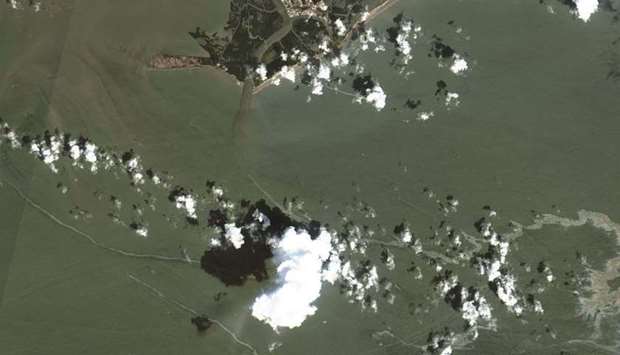The US Coast Guard (USCG) said yesterday that it is investigating nearly 350 reports of oil spills in and along the US Gulf of Mexico in the wake of Hurricane Ida.
Packing winds of up to 150mph (240kph), Ida roared through Louisiana last Sunday, causing catastrophic damage, according to local authorities.
Downgraded later to tropical storm status, Ida nonetheless retained raw power as it rumbled through the US Northeast, leaving dozens dead.
It was in the petroleum-rich Gulf of Mexico that, in 2010, an explosion ripped through the Deepwater Horizon oil platform, touching off the worst oil spill in history.
About 88% of the region’s offshore oil production remains shut and more than 100 platforms unoccupied after the storm made landfall on August 29.
The Coast Guard has been conducting flyovers off the coast of Louisiana looking for spills.
It is providing information to federal, state and local authorities responsible for cleaning the sites.
Flights on Sunday found evidence of a new leak from an offshore well and reported another leak responsible for a miles-long streak of oil was no longer active.
A third report of oil near a drilling platform could not be confirmed, it said.
Offshore oil producer Talos Energy Incorporated, which hired divers and a clean-up crew to respond to an oil spill in Bay Marchand, said old pipelines damaged during the storm were apparently responsible.
The source of the Bay Marchand leak remains unknown, said Coast Guard spokesman Lieutenant John Edwards.
A Coast Guard-led team “will be looking at all potential sources in order to ensure any future risk is mitigated”, he said.
The spill off the coast of Port Fourchon, Louisiana, had decreased substantially since it was first discovered last week, Talos said.
The company is not the owner of the pipelines and had ceased production operations in the area four years ago, said spokesman Brian Grove.
An offshore well belonging to S2 Energy was discharging oil about five miles (8km) away from the Bay Marchand site, the Coast Guard said.
The company told the Coast Guard that it has secured the wellhead and it was no longer discharging oil.
S2 did not immediately reply to a request for comment.
The Louisiana Department of Environmental Quality (LDEQ) said it is working with the Coast Guard and the US Environmental Protection Agency (EPA) to require companies responsible for any spills to halt and clean up the discharges.
“If necessary USCG and/or the EPA can open federal funding streams to cover mitigation costs,” LDEQ said.
US Southern states are meanwhile still grappling with widespread power outages, and water-logged homes faced new flash flood threats yesterday from slow-moving rain and drenching thunderstorms.
Storms capable of producing 2-3” (5-8cm) of rain “in a pretty short period of time” were saturating New Orleans and other parts of Louisiana and Mississippi, and were expected to continue into the evening, said National Weather Service (NWS) meteorologist Lara Pagano.
More than 500,000 customers in the state remained without power yesterday, according to the PowerOutage.us website, which tracks power outages.
“Some of that (rain) will occur over soil that is saturated by Ida, areas that are already sensitive, with any additional heavy rain problematic and leading to flash flooding,” Pagano said.
President Joe Biden has approved disaster declarations for Louisiana, which he visited on Friday, as well as for New York and New Jersey, where he will travel today.
The declarations qualify the states for federal assistance for repairs and rebuilding after the intense flooding that also killed dozens in the US Northeast.
New York Governor Kathy Hochul said Ida caused more than $50mn in damage in that state after the storm’s record-breaking rainfall of 3.1” (7.8cm) per hour on Wednesday, recorded in New York City’s Central Park, sent walls of water cascading through businesses, public transportation systems and 1,200 homes.
Hochul said she had directed that $378mn in previously-awarded hazard mitigation funding from the Federal Emergency Management Agency (FEMA) be devoted to supporting New York’s infrastructure against extreme weather.
Biden will travel to Manville, New Jersey, and the Queens borough of New York City today to assess damage from Ida.
New York had 17 confirmed deaths from Ida: four in suburban Westchester County, and the rest in New York City.
In New Jersey, there were at least 27 confirmed storm deaths and four people missing, a governor’s spokesperson said.
Another large storm, Hurricane Larry, churned yesterday about 715 miles (1,150km) off the Northern Leeward Islands.
Predicted to remain out to sea in the Atlantic Ocean, Larry was expected to cause “significant swells” along the US East Coast from midweek until the weekend, the NWS’s Pagano said.
“These swells will likely cause life-threatening surf and rip-conditions so beach-goers are urged to follow the guidance of lifeguards and local officials,” she said.

This handout satellite image released by Maxar Technologies shows oil slicks from spills in the Gulf of Mexico, off the coast of Louisiana.
